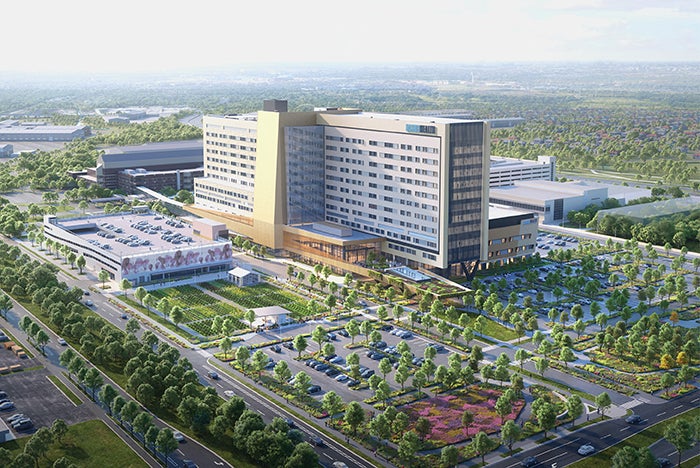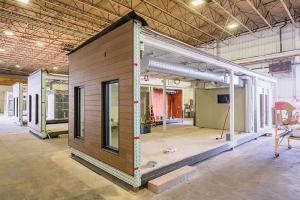Hospital projects revitalize neighborhoods, elevate patient care

Harris Health is investing in a new 12-story hospital scheduled to open in 2029.
Image courtesy of Harris Health’s Lyndon B. Johnson Hospital
Three billion-dollar-plus hospital projects are poised to break new ground in energy conservation, community revitalization and innovative design. Harris Health’s Lyndon B. Johnson Hospital in Houston, Cooper University Health Care’s expansion in Camden, N.J., and University of California San Francisco’s (UCSF’s) Helen Diller Hospital all bring unique elements to their projects that contribute to defining innovation in the health care construction space.
“The growing population in Houston, the large portion of underserved people in our area and the over-capacity in area emergency departments are driving factors behind the construction of our Level I trauma-capable hospital,” says Patrick Casey, RA, MBA, ACHE, senior vice president of facilities construction and systems engineering at Harris Health System. The 12-story, 1.3-million-square-foot facility, on the campus of the Lyndon B. Johnson Hospital, will include 390 private patient rooms with the capacity to flex to an additional 60.
Originally budgeted at $1.6 billion, the cost has risen to $2 billion due to inflation and rising construction costs. The new facility is scheduled to open in early 2029. Construction includes unique flood control features designed to mitigate the potential for flooding.
“We have 8.5 million gallons of rainwater retention in six underground water tanks to store rainwater, and the hospital is being constructed on top of a crawl space to prevent future flooding,” Casey says. Moisture-resistant drywall and dense glass were included in initial construction to further mitigate flooding risk and potential flooding damage.
An orchard will replace a former gas station and will be coupled with an on-site farm, designed to carry out the hospital’s Food Farmacy program, which serves the estimated 55% of the population in the hospital’s major service area who live at or below the federal poverty level and in a food desert.
“We prescribe healthy food for people as part of our Food Farmacy, which also trains people how to eat healthier,” Casey noted. “Instead of medication, the Food Farmacy gives out vegetables, fruits and fresh food to the people in our service area to help them become healthier and stay healthy.”
Cooper University Health Care’s Project Imagine, a $3 billion expansion project, features three towers that will accommodate up to 745 private inpatient beds and add a new regional medical coordination center and additional surge capacity to bolster New Jersey’s emergency infrastructure. The first tower, which will be 10 stories and 345,000 square feet, is expected to be completed by 2028 and will be connected by a bridge to the MD Anderson Cancer Center at Cooper.
“This project also will empower Cooper’s dedicated, expert physicians, nurses and health care professionals to provide patients with the highest quality of care in facilities that match their skills,” says Anthony Mazzarelli, M.D., co-chief executive officer of Cooper.
To contribute to economic development in Cooper University Health Care’s service area in Camden, N.J., the hospital partnered with the Eastern Atlantic States Regional Council of Carpenters and its construction manager, Torcon Inc./P. Agnes Inc., in creating hiring preferences for Camden residents during construction as well as overall workforce inclusion, hiring and recruitment for apprentice programs.
The $4.3 billion UCSF Helen Diller Hospital construction project sits at 880,000 square feet and encompasses 324 patient beds, 22 new operating rooms and 31 new emergency care beds. The hospital will open in 2030. Featuring a central utility plant designed to enhance campus resiliency, energy efficiency and carbon reduction, the redundancy within the system will allow the hospital to island itself from the campus should a catastrophic event disrupt power. Heating and cooling are provided by heat recovery systems and cooling-only electric chillers, which are configured to take advantage of the most efficient chillers available on the market.
To contribute to community development, UCSF is investing $20 million in public transit improvements, including $11 million to augment a hybrid light rail and streetcar line in the city. UCSF also will plant two trees for every one tree displaced by construction.
“This is a huge investment that will bring people to the city and solidify San Francisco’s reputation as a destination for world-class care,” says Suresh Gunasekaran, president and chief executive officer of UCSF Health.




